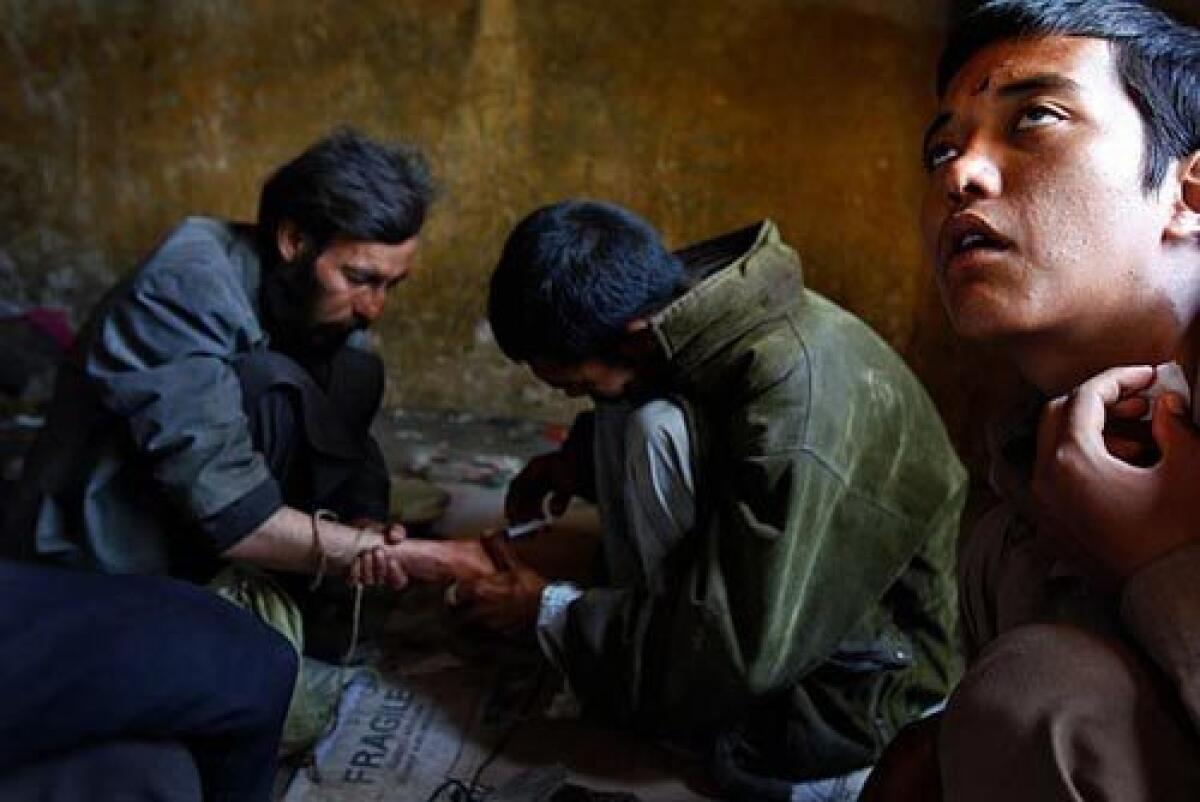Afghanistan faces growing addiction problem

The heroin fumes rose, gray and twisting, into the nostrils of Mohammed Jawad Rezaie.
He inhaled and relaxed. For a few moments, Rezaie stopped scratching at his lice-infested groin. He lost interest in the blackened, rotting toes of his left foot, which had mesmerized him minutes earlier.
In another room in the shell-pocked ruins of the former Russian Cultural Center in downtown Kabul, 27-year-old Anwar injected a mixture of heroin and water into a bulging vein in the thin wrist of a man called Hussein.
Anwar, who injects addicts in exchange for heroin, withdrew the needle as Hussein’s head slumped forward. Hussein began to tremble, and Anwar wrapped him in a hug, holding him until he relaxed and dropped into a peaceful stupor.
A junkie named Jaffer who had just been injected in the neck squatted next to them, his head cocked back, his eyes staring blankly at the ceiling.
Afghanistan is notorious as the world’s leading producer of opium and heroin, most of it shipped to Europe. Less well-documented is the country’s own addiction epidemic. As many as a million Afghans, mostly men but increasing numbers of women, are addicted to heroin or opium, according to Afghan counter-narcotics police.
“It’s bad, and it’s getting worse,” said Syedagul Stanekzai, the harried project manager of a men’s drug rehabilitation center in Kabul, the capital.
The center has 100 beds in a city where thousands of addicts roam the streets. He cited varied reasons for the increase in addiction rates: lack of security, a high unemployment rate, general hopelessness and the wide availability of cheap drugs.
A hit of opium sells for as little as 10 afghanis, or 20 cents. A dose of heroin sells for 60 cents. In certain neighborhoods, drugs can be bought as easily as a cup of tea.
Drug use has been practically decriminalized.
“We prefer persuasion,” Lt. Mohammed Edriss of the Kabul counter-narcotics police said in the cultural center’s maze of crumbling buildings. He watched an addict named Nazir light a narrow ribbon of heroin and inhale the smoke
“See this?” the lieutenant said, snatching a packet of heroin from Nazir’s hand. “You can get it anywhere. So why arrest these people? They’ll just go back and get more.”
The lieutenant returned the packet to Nazir. “Better they should get treatment, not jail.”
He gave Nazir a gentle shove, ordering him to stop smoking and go to a rehab center.
Almost every day, Edriss and his officers try to herd the bedraggled addicts from the gloom and stench of the cultural building to a nearby rehab center, if not for treatment, then at least for showers and food.
The Afghan government has long considered drug addiction a uniquely Western vice. Officials never tire of telling Westerners that if it wasn’t for the market for narcotics in their countries, Afghan farmers would have no incentive to grow poppies.
But the flow of drugs into Afghanistan’s own cities has changed attitudes, said Gen. Shaista Turabi, director of the counter-narcotics police.
“My suggestion would still be for the U.S. and Europe to decrease demand,” Turabi said in his spacious Kabul office, with new radio-equipped police SUVs parked outside, provided by Western aid. “But I can also say that addiction is a big problem in Afghanistan, too, and a big drain on the whole country.”
Since 2002, Western nations have tried to eradicate Afghan opium poppy fields -- a multibillion-dollar effort that Richard Holbrooke, the U.S. special envoy to Afghanistan and Pakistan, has called “a waste of money.”
In June, Holbrooke said that the U.S. would phase out poppy-eradication efforts and focus on encouraging alternative crops and arresting major traffickers.
Even though Afghan poppy yields last year declined 19% from a record harvest in 2007, according to the United Nations, it was still the second-highest since 1994.
The easy availability of opium has prompted a steady increase in the number of female addicts, drug treatment professionals say. Many women who weave carpets by hand take opium to ease the pain of the hard physical labor; some give the drug to their children to sedate them while they weave.
Last month, an 8-year-old boy and his 3-year-old sister were being treated for opium addiction while their mother underwent detox, said Huma Mansoori, one of two doctors at the Sanga Amaj drug treatment center for women.
The center, which opened in 2007, was Afghanistan’s first rehab facility for women. It still is the only one in Kabul; there are three centers elsewhere.
Tajwara, 35, a mother of nine, said her husband gave her opium when she was ill. She was addicted for several years until she sought treatment last month at the Sanga Amaj center.
“I didn’t know smoking opium was bad for me,” Tajwara said. “People said it was medicine. If I had known it would ruin my life, I never would have tried it.”
Shekiba, a slender girl of 15, covered her face in shame as she described how her father got her addicted to opium when she was 12.
“I knew opium was wrong, but I couldn’t control it on my own,” Shekiba said. She had just completed a drug detoxification program, along with several other women stricken with vomiting and diarrhea from withdrawal.
Although male addicts smoke and shoot up fairly openly, women almost always use drugs at home. And though men can seek treatment on their own, women must get permission from husbands or fathers to enter rehab programs.
“Afghan culture puts great shame on women who use drugs,” said Dr. Torpikay Zazai, director of the women’s center. “Men are ashamed of their women if they’re addicted. They want to hide it in the home, and not let their women out for treatment.”
Women tend to smoke opium or drink it in tea, but they rarely use heroin, Zazai said. Men favor heroin, though many also smoke opium.
At the former cultural center, men smoke and shoot up day and night. The floors are littered with syringes, garbage and human waste. What appear to be corpses line the dank hallways, but the forms are actually addicts sleeping off highs. Many of the men wear filthy shalwar kameez, the traditional Afghan tunics and pants. A few are dressed in clean shirts and slacks -- “day trippers” who stop by to smoke, then return to work.
Abdullah Gaafar, 21, sat smoking amid the stench of urine. He said he smokes heroin at least twice a day, more often if he can raise money from odd jobs.
Neither his family nor his fiancee knows he’s an addict, Gaafar said.
“I’m ashamed of what I’ve become. I need to go to the treatment center,” he said, his voice trailing off as the heroin took effect.
Rezaie, 27, the addict with the lice and infected foot, said he started doing drugs at 14, working in Iran. He pays for the heroin by begging.
“The people insult me a lot,” he said. When he tries to buy bread, he said, bakers tell him: “I’m a drug addict and I shouldn’t get bread -- I should die.”`
Four addicts died in the complex last winter, said Rezaie, who appeared close to death himself.
He shrugged and put a flame to the foil beneath his heroin. “I feel tired if I don’t smoke,” he said. “I feel like destroying myself.”
A week later at the Wadan men’s drug treatment center a few blocks away, addicts fresh off the street squatted on the floor of a bare detox room. With their shaved heads and pale uniforms, they looked like prison inmates.
The addicts spend 10 days in detox and 20 more receiving medical treatment, drug counseling and religious education. An imam is on staff, and there are regular prayer sessions.
The newest arrival that day was Jaffer, the addict who had been injected in the neck at the abandoned cultural center a week earlier. His head freshly shaven, he vowed to get clean, stay clean and reunite with his family.
“I have made a mistake,” he said, “and I must make up for it.”
Stanekzai, Wadan’s project manager, has heard such promises before. Surrounded by a roomful of addicts, each solemnly swearing off drugs, he was asked whether some of those earnest young men might go right back to the wrecked cultural center after completing the program.
“Of course,” he replied.
More to Read
Start your day right
Sign up for Essential California for news, features and recommendations from the L.A. Times and beyond in your inbox six days a week.
You may occasionally receive promotional content from the Los Angeles Times.







